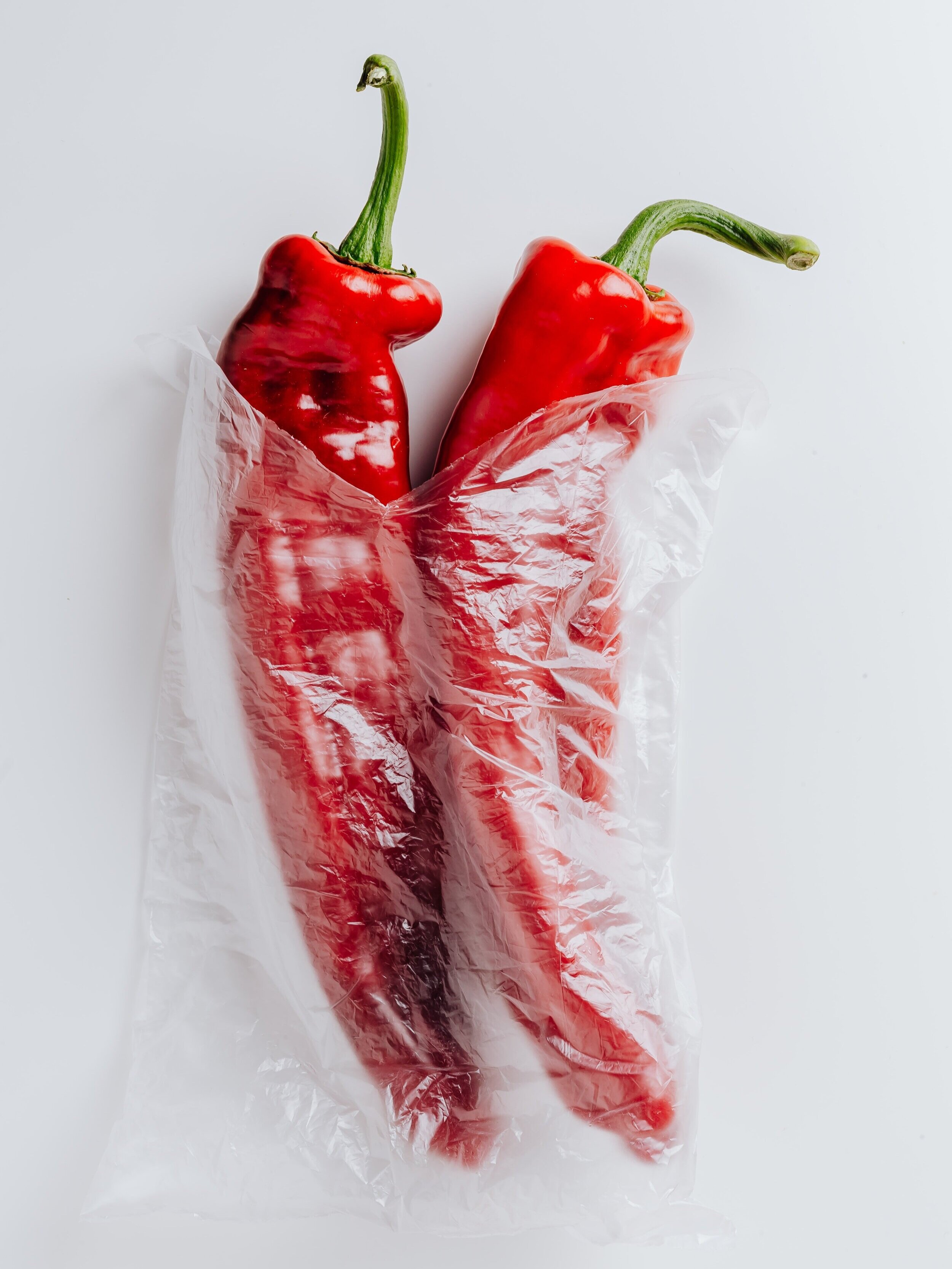Food Porn: A Desolate Cornucopia
Pictured: two red peppers in a clear plastic bag on a white background.
Feb 5th, 2021 | By Sharla Moody BK ‘22
With the inventions of television and the internet, virtually everything can be photographed, videotaped, and uploaded for viewing and enjoyment. In some cases, this advent has ushered in important artistic innovations, like the Golden Age of Hollywood, which produced some of the most important films and artistic endeavors in centuries. Television and the internet have served as democratizing tools, making even niche educational subjects widely accessible. Some things primarily aimed at instruction, like cooking shows, have become a television staple, and others aimed at entertainment and pleasure, like pornography, infiltrate nearly every corner of the internet. On the surface it may seem like food and pornography are the most dissimilar subjects, but Kurt Vonnegut humorously paralleled the two in his 1973 novel Breakfast of Champions:
And Trout made up a new novel while he sat there. It was about an Earthling astronaut [Don] who arrived on a planet where all the animal and plant life had been killed by pollution, except for humanoids. The humanoids ate food made from petroleum and coal. [….]
They asked Don if dirty movies were a problem on Earth, too, and Don said, “Yes.” They asked him if the movies were really dirty, and Don replied, “As dirty as movies could get.” This was a challenge to the humanoids, who were sure their dirty movies could beat anything on Earth. So everybody piled into air-cushion vehicles, and they floated to a dirty movie house downtown. [….]
So the theater went dark and the curtains opened. At first there wasn’t any picture. There were slurps and moans from loudspeakers. Then the picture itself appeared. It was a high quality film of a male humanoid eating what looked like a pear. The camera zoomed in on his lips and tongue and teeth, which glistened with saliva. He took his time about eating the pear. When the last of it had disappeared into his slurpy mouth, the camera focussed on his Adam’s apple. His Adam’s apple bobbed obscenely. He belched contentedly, and then these appeared on the screen, but in the language of the planet: THE END. [1]
While Vonnegut seems to prophesy environmental disaster that could cause a perverse, sexualized view of food, he also foretold the creation of food porn, or food media that features decadent, glamorized shots of food. The term “food porn” clearly links it to pornography, though it need not be—and is almost never—actually sexualized; rather, the comparison stems from the decadence and extravagance in food media. Videos and photos that can be categorized as food porn glut social media feeds. If you logged onto Instagram today, you’d likely encounter it at some point: a video of a seriously underbaked cookie being torn in half to reveal a deluge of melted chocolate, photos of greasy burgers stuffed with bacon and far more cheese than would taste good, chocolate shaped on a potter’s wheel to make artistic shapes and statues. They’re fun clips to watch, especially if, like me, you’re prone to procrastination.
The idea of food porn dates to 1977, when leftist journalist Andrew Cockburn wrote that “[t]rue gastro-porn heightens the excitement and also the sense of the unattainable by proffering colored photographs of various completed recipes.” [2] Today, food porn usually refers to images or videos of glamorized, overextravagant food, in a style similar to glamour photography or sexual pornography.
Other types of food media might fall under the food porn category, like mukbang, which means “eating show,” a trend that originated in South Korea. In Korean culture, eating with family is at the center of meals. With the rise of divorce, single households, and excess work, it’s become less of a reality and more an artifact of cultural history to eat together. In turn, mukbang began, “in which a person eats enormous servings of food in front of a webcam, while conversing with the people watching.” [3]
On the surface, there doesn’t seem to be anything wrong, per se, about food porn, though instinctively something does feel wrong about it. Aesthetic appearance is certainly of some importance to food, especially in the professional cooking world, but the primary end of food is—or should be—to be consumed. Food, after all, is produced to be eaten, to taste good, to provide our bodies with needed nutrition. We do not consume food with our eyes; we chew and digest it. While the term “culinary arts” implies an aesthetic importance, the aesthetics of appearance—rather than those that contribute to taste or smell—do not directly contribute to our enjoyment of food for its proper end, which is to be eaten.
Food is scripted to be eaten, simply because it is a thing that is made to be consumed. Food is perishable and cannot stand as a piece of art forever. If food is to meet its primary end, it must be eaten at some point. We do not, after all, plow fields, harvest vegetables and fruit, and butcher animals simply to make a visually-pleasing dish to sit in a gallery for a day before being emptied into the trash. We make food because we need to eat it. This will always be food’s primary purpose.
Food porn, like sexual pornography, reduces or makes us forget the stakes of what is being depicted. Food requires sacrifice. Animals are killed–– and often treated in atrocious ways in the meat industry––and countless people toil over crops, often laboring for little pay, to provide us food. When food is presented as a glamorized item chiefly to be salivated over, no consideration is given to the actual effort and work needed to provide us with sustenance. Sexual pornography, on the other hand, reduces sex to a physical act documented and viewed for the sake of voyeurism and temporary gratification. Abuses in the porn industry are well documented, but even beyond these considerations, the objectification of people into mere sexual objects strips them of personhood. [4] When we view people as instruments to be used for our pleasure, we selfishly fail to recognize people as individuals worthy of dignity, with full personhood outside of their capabilities in relation to our own utilities. Likewise, when we view food as an item to be salivated over rather than actually consumed, we strip eating of the sacrifices that make it possible: all the animals raised for slaughter, the workers who slave on farms to pick fruits and vegetables, the cook who may barely scrape by working in a restaurant. When the chief end of food becomes visual rather than edible, food ceases to exist. Instead, what was meant to be eaten becomes an intangible flicker on a screen. Voyeurism in all forms reduces things to utilitarian items, separating personhood from people turned into sexual objects, nutrients and sacrifice from food turned into entertainment.
Food has secondary ends, of course. I like food that tastes good. I like food that smells good. The sensory experience of eating directly correlates to our enjoyment of food. Cooking and eating have also been ritualized. Quality time with loved ones, dates with romantic partners, and celebrations are all centered around food. Food is at the center of culture and our interactions with people.
But food porn defamiliarizes food and separates it from all its natural ends. Food in videos or photographs cannot be eaten by viewers, and it’s not always clear whether food in food porn should be eaten by anyone. Some media features obscenely greasy, overstuffed, undercooked food. In one viral video that debunked glamour shots of food, glue was drizzled around the edges of a pizza slice to give the effect of gooey mozzarella cheese, while rendering it physically unsafe to eat. Food in videos cannot be smelled or tasted, only viewed. Almost always, these videos are watched by individuals scrolling on social media, meaning there isn’t even a communal experience of watching a video with another person. This media also presents food without any context: food is removed it from the culture of its origin and packaged neatly for solitary viewers to gaze upon during their social media scrolling. Philosopher Sir Roger Scruton wrote,
Eating has in every traditional society been regarded as a social, often a religious, act, embellished by ritual and enjoyed as a primary celebration of membership. Rational beings are nourished on conversation, taste, manners and hospitality, and to divorce food from these practices is to deprive it of its true significance. [5]
What does it mean for food to be a social media trend rather than a tool fundamental to our human needs of nourishment and community? When the nutrition and the sensory experience of eating are subjugated to the visual aesthetics of food that viewers will never consume, we convince ourselves that extravagance serves a purpose greater than that which is dictated by God and nature. A culture primed to objectify—food as well as people—trades intended goodness for commodification, reducing all that makes life meaningful into impersonal items only appreciated for their utility in immediate, temporary gratification. When people are objectified, they are stripped of their human dignity. When we objectify food, we deprive ourselves of the dignity that comes from eating and fellowship.
Notes
[1] Vonnegut, Kurt. Breakfast of Champions. New York: Delacorte Press, 1973.
[2] Cockburn, Andrew. “Gastro-Porn.” The New York Time Review of Books, 8 December 1977.
[3] Holmberg, Christopher. “Food and Social Media—A Complicated Relationship.” HuffPost, 5 May 2014, https://www.huffpost.com/entry/food-and-social-media-a-c_b_4898784.
[4] Kristof, Nicholas. “The Children of Pornhub: Why does Canada allow this company to profit off videos of exploitation and assault?” The New York Times, 4 December 2020.
[5] Scruton, Roger. “Eating our Friends.” Right Reason, 26 May 2006.



Feb 5th, 2021 | By Raquel Sequeira TD ‘21+.5
The cover of Wired magazine’s March 2020 issue featured a scoop of fluorescent sherbet ice cream floating like a strange new planet amongst the stars. In the first month of the coronavirus pandemic, the piece zoomed out from earth: “Humans are headed for the cosmos, and we’re taking our appetites with us. What will fill the void when we leave Earth behind?”